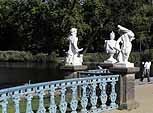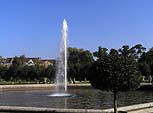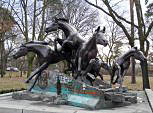for example...
a) Berlin highlights – the "musts"
 For those who are new to Berlin: the Brandenburg Gate and the Eastside Gallery, the Kaiser Wilhelm Memorial Church and the dome of the Reichstag – not only the “classical” sights but also original, off-the-tourist-trail perspectives on the city’s symbolic places are on offer.
For those who are new to Berlin: the Brandenburg Gate and the Eastside Gallery, the Kaiser Wilhelm Memorial Church and the dome of the Reichstag – not only the “classical” sights but also original, off-the-tourist-trail perspectives on the city’s symbolic places are on offer.
b) Berlin’s historic heart
 Histories and happenings around Berlin’s oldest district…home of the soldier king’s stables and E.T.A Hoffmann’s drinking den, where Frederick the Great set the architectural tone, where the GDR made and passed into history and a baroque palace is now to be rebuilt…where the cradle of Berlin was once to be found...
Histories and happenings around Berlin’s oldest district…home of the soldier king’s stables and E.T.A Hoffmann’s drinking den, where Frederick the Great set the architectural tone, where the GDR made and passed into history and a baroque palace is now to be rebuilt…where the cradle of Berlin was once to be found...
c) Modern Berlin
From the ONE-billion-euro project of our central railway station, along the Spree via the government quarter with its clean modern lines …all the way to Peter Eisenmann’s Field of Stelae, dedicated to the murdered Jews of Europe, and the former no-man’s-land on which high-rise blocks, vast by Berlin standards and bearing the signatures of famous architects, have arisen.
d) The Museum Island
The island of temples to art and the muses, created in the hundred years from 1830 to 1930, architectural testaments to the spirit of the times that gave rise to them: from the Humboldtian ideal of education to the art palace of the Hohenzollerns…a tour designed to give an overview of the area that has been declared a UNESCO World Heritage Site, including visits into one or two selected museums.
e) The Wall Tour
 20 years after the Fall of the Wall, which brutally divided not just East and West Berlin but a whole continent, we go looking for traces. A left-over section of the wall gives an impression of the vast bulwark that it once was, an old watchtower provides mute testimony to the tragic death of the Wall’s first victim; if we then follow the cobbled strip on the ground right up to Bernauer Strasse we can relive in vivid detail the attempts to escape through claustrophobic tunnels and in dramatic plunges from windows.
20 years after the Fall of the Wall, which brutally divided not just East and West Berlin but a whole continent, we go looking for traces. A left-over section of the wall gives an impression of the vast bulwark that it once was, an old watchtower provides mute testimony to the tragic death of the Wall’s first victim; if we then follow the cobbled strip on the ground right up to Bernauer Strasse we can relive in vivid detail the attempts to escape through claustrophobic tunnels and in dramatic plunges from windows.
f) Kreuzberg SO 36
 Do you fancy something by way of contrast? Go to Kreuzberg!
Do you fancy something by way of contrast? Go to Kreuzberg!
Proud locals will tell you that the real Kreuzberg is Kreuzberg SO36: what used to be the south-eastern part of the district. Here it was that the 60’s gave rise to communes; here the squatter scene flowered and flourished; and here the infamous May Day riots began. Multiculturalism isn’t just a word here but a reality.
An insight into the life of this lively and fashionable district.
g) Enjoying art
It all started with Friedrich Loock: in 1988 he turned his living room in the "Spandauer Vorstadt" into a 45 square-metre gallery – the "living machine". His success after the fall of the Wall attracted many like-minded people, turning the area in short order into an El Dorado for contemporary art. We pick out about five galleries and study some ambitious exhibitions.
h) Geomantic city tour
What is it that really holds Berlin together? Take the plunge into an unseen world: where do the places of power pulsate in the city, where do the channels of energy flow? What effect do they have on us, and we on them?
An introduction to the background of geomantic work. Please be aware that participants are asked to play an active part in the perceiving and healing work carried out for this city.
